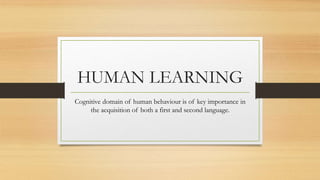
HUMAN LEARNING THEORIES AND SECOND LANGUAGE ACQUISITION
- 1. HUMAN LEARNING Cognitive domain of human behaviour is of key importance in the acquisition of both a first and second language.
- 2. PROCESS OF LEARNING Perceiving attending stroring recall Central tasks of internalization of language
- 3. History of learning theory • Ivan Pavlov • Classical conditioning • John B. Watson – Behaviourism • Classical conditioning as the explanation for all learning: by the process of conditioning , a building of stimulus-response connections, and more complex behaviuors are learned by building up series of of responses. Learnign process Formation of associations Between stimuli and refelxive responses
- 4. History of learning theory • B. F. Skinner • Respondent conditioning concern with respondent behaviour • Operant conditioning = behaviour in which one “operates” on the environment; with this model the importance of stimuli is de-emphazised. • The stimuli reinforces the response and that tend to strengthen behaviour. Behaviour Elicited By a preceding stimulus
- 5. History of learning theory • AUSUBEL´S MEANINGFUL LEARNING THEORY • Learning takes place in the human organism through a meaningful process of relatining new events or ítems to already existing cognitive concepts. • Knowledge= the acquisition of new meanings • Retention= the phychological organization of knowledge as a hierarchical structure, and the eventual ocurrence of forgetting. Any learning situation can be meaningful If learners have a meaningful learning set, a disposition to relate to new learning task to what they already know If the learning task itself is potentially meaningful to the learners, relatable to the leaerner´s structure of knowledge
- 6. History of learning theory • ROGERS´S HUMANISTIC PSYCHOLOGY • Affective focus on learning than cognitive approach. • Rogers studied the whole person as a physical and cognitive, but primarily emotional being. • According to Rogers “Fully Functional persons” live at peace with all their feelings and rections; they are able to reach their full potential. • The focus in on learning rather than teaching • Teachers need to become facilitators of learning through the establishment of interpersonal relations with learners.
- 8. Types of learning • Signal learning: learners make a general diffuse response to a signal. • Stimulus: response learning. Learner acquires a precise response to a stimuli. • Chaining: what is acquire is a chain of two or more stimulus-response connections. • Verbal association:learning of chains that is verbal. This is a special type of chaining because internal links may be selected from previous learning repertoire of language. • Multiple discrimination: learns a number of different responses to diffferent stimuli. • Concept learning: learner acquires the the ability to make common response to a class of stimuli. • Principle learning: chain of two or more concepts. It functions to organize behaviour and experience. • Problem solving: learning that requires internal events called “thinking”. Previous principles and concepts are combined in a conscious set of events.
- 9. Second language learning process BY MEANS OF THE EIGHT TYPES OF LEARNING Signal learning: emotional, cognitive, verbal response to language Stimulus-response learning to sound system of a foreign language by trial and error in pronunciation Chaining in phonological sequences and syntatic patterns Verbal and no verbal chain Multiple discrimination to distinguish several meanings of words or rules from the native language to the new language
- 10. Second language learning process BY MEANS OF THE EIGHT TYPES OF LEARNING Concept learnign: the notion that language and cognition are interrelated. Linguistic rules need to be learned. Principle learning: rules and memory are part of a total system for language learning Problem solving: learner face sets of events that need to be solve: Determining the correct meaning of a word, interpretation of utterance, conversational approach
- 11. L2 Learning and Teaching • RELATIONSHIP OF L1 AND L2 • All languages are learnable • Knowledge of L1 is an important component of all L2 competence in its initial state, but the genetic, typological, and historical relationships of L1 and L2 will yield differential possibilities for positive transfer of parameter settings and surface-level features, including vocabulary and writing system.
- 12. APTITUDE & age • Aptitude is an important predictor of differential success in L2 learning, but it is not completely deterministic. • Learners differ in capacity to discriminate and process auditory input. Brain plasticity Not analytical Fewer inhibitions Weaker group identity Simplified input more likey Learning capacity Analytic ability Pragmatic skills Greater knowledge of L1 Real-world knowledge Youngeradvantage Olderadvantage
- 13. COGNITIVE STYLE • The way individuals prefers to process. • Related to and interacts with personality factors and learning strategies. • FIeld-dependent/field-independent (FD/FI) dimension • Deductive or inductive processing. • Matter of cognitive style is sensory preference for processing input: visual, auditory, kinesthetic (movement-oriented), or tactile (touch-oriented).
- 14. PERSONALITY • Little study has been carried out on other personality factors in relation to differences in L2 outcomes, but there is some evidence that being imaginative or creative, empathetic, and tolerant of ambiguity is advantageous. • Factors like anxiety, self-confident, risk-avoiding, risk-taking, shyness, adventuresome, introverted, extroverted, inner-directed, other-directed, reflective, impulsive, imaginative, uninquisitive, creative, uncreative, empathetic, insensitive, tolerant of ambiguity, closure-oriented.
- 15. LEARNING STRATEGIES • Selection from among possible strategies is often a conscious choice on the part of learners, but it is strongly influenced by the nature of their motivation, cognitive style, and personality, as well as by specific contexts of use and opportunities for learning. The other variables we considered earlier in this section – age, sex, and aptitude – also play a role in strategy selection. • Learning strategies are culturally based: individuals learn how to learn as part of their socialization experiences, and strategies they acquire in relation to other domains are commonly transferred to language learning.